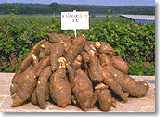 |
 This Just In ... This Just In ...
|
 |
NSF Statement
on Completion of South Pole Medical Air Drop
A U.S. Air Force C-141 cargo jet has successfully air-dropped
the medical supplies needed to treat a woman spending
the winter months at the U.S. National Science Foundationís
Amundsen-Scott South Pole Station. The 47-year-old
patient, whose identity is being kept confidential,
recently discovered a lump in one of her breasts.
The plane arrived at the South Pole at 1:30 a.m. (U.S.
Eastern time) on Sunday, July 11. The drop took place
at approximately 1:55 a.m. Station personnel retrieved
all six of the dropped bundles, which contained medical
supplies and equipment. More...
|
 |
 |
|
Photo courtesy CGIAR and
the International Institute of Tropical
Agriculture (IITA)
|
Where the Wild Ones Are:
Origins of Staple Crop Found
As the 20th
century draws to a close, little is yet known about
the origins of a staple subsistence crop that feeds
an estimated 600 million Third World people. The cassava
(Manihot esculenta), a bushy plant producing tubers
-- starchy underground stems -- have fed the indigenous
people of the Americas for millennia, and much of
Africa since the 17th century. But now NSF-funded
biologists affiliated with Washington University in
St. Louis have written the ultimate "roots" story
for this plant. Researcher Barbara Schaal has pinpointed
cassava's origins to the southern border of the Amazon
River basin in Brazil. Tracing variation in a single
gene found in cultivated and wild cassava using sophisticated
DNA sequencing techniques, Schaal identified a cassava
subspecies, still present in the diminishing wilds
of the Amazon basin, as the plant's progenitor. Her
work reveals a wealth of genetic diversity in wild
and domesticated cassava strains, information that
plant breeders can use to create hardier plants that
are more resistant to disease.
More...
|
 |
 |
 |
Photo courtesy Gemini Observatory,
National Science Foundation and the University
of Hawaii Institute for Astronomy
|
New
Telescope Gives Astronomers a Clearer Vision of the
Universe
At the recent
dedication of Gemini North in Hawaii, astronomers
revealed some of the sharpest infrared images ever
obtained by a ground-based telescope. These first
high-resolution images from one of the largest telescopes
in the world, near the summit of Mauna Kea, show the
remarkable power of the telescope's technologies,
which minimize distortions that have blurred astronomical
images since Galileo first pointed a telescope skyward
almost 400 years ago. The clarity of these images
is equivalent to resolving the separation between
a set of automobile headlights at a distance of 2,000
miles! Built by an international partnership of seven
nations, Gemini North is the first of two 8-meter
telescopes that together can explore the entire northern
and southern skies in optical and infrared light.
More...
|
 |

"Robofly" Solves Mystery of Insect Flight
Insects have
been flitting about the planet far longer than any
other creature, yet how they manage to stay aloft
has been a mystery. But now, a University of California,
Berkeley, biologist funded by the National Science
Foundation (NSF) has solved the riddle. Using a pair
of robotic wings he has dubbed "robofly," Michael
Dickinson and his colleagues have found three distinct
wing motions that not only allow insects like flies
and bees to stay airborne, but also let them steer
and execute amazing acrobatic maneuvers. These mechanisms
seem to be common to most insects, and perhaps even
to the hummingbird. "We now have a unified theory
of insect flight aerodynamics that explains how they
can steer and maneuver," says Dickinson. "We've solved
the old riddle."
More...
|
 |

Singaporean Math Education "Demystified"
U.S. students'
generally dismal achievement in mathematics, as revealed
in international comparisons, has prompted a national
self-examination for practical answers to the question
of how to boost America's rank in math performance.
In one effort by mathematics educators at the University
of Washington-Seattle, mathematicians and graduate
students are comparing the middle school math curricula
materials of Singapore -- whose students are the top
math performers internationally - against two widely
used sets of math materials whose development was
supported by the National Science Foundation. This
comparative study will entail a thorough examination
of mathematics instructional materials in grades six
through eight.
More...
|
 |
 
|

